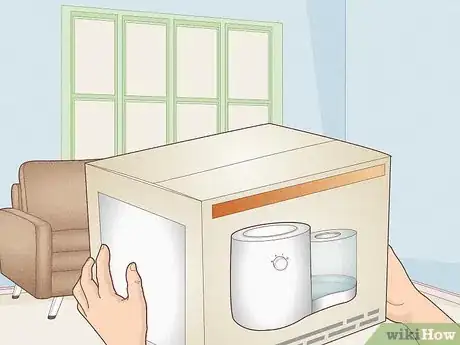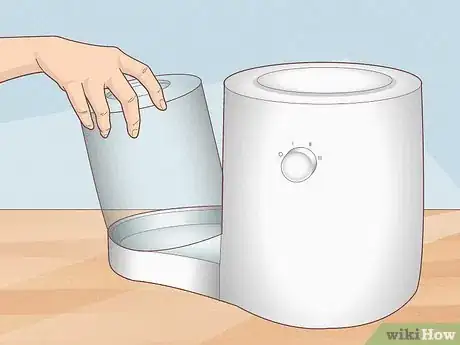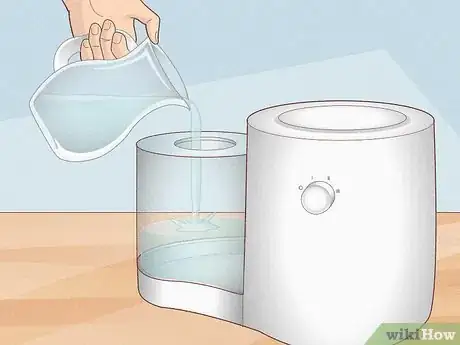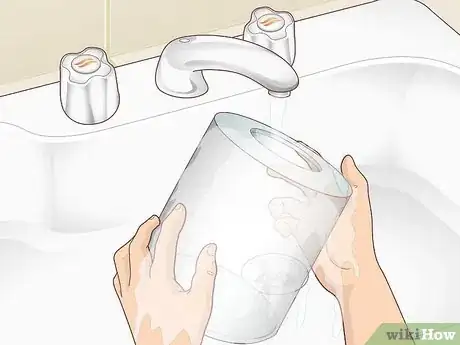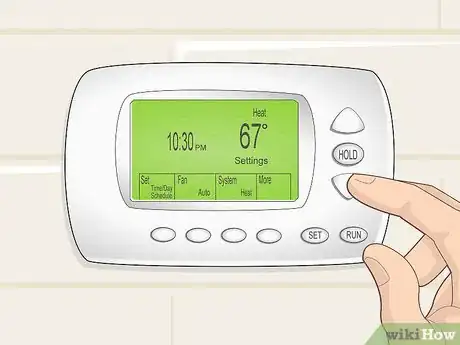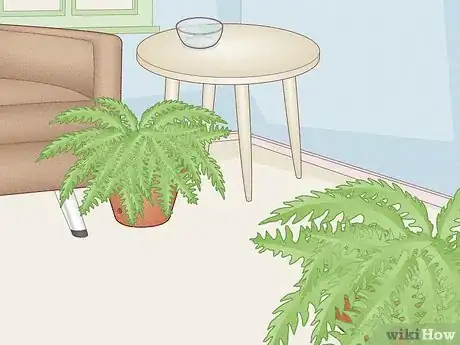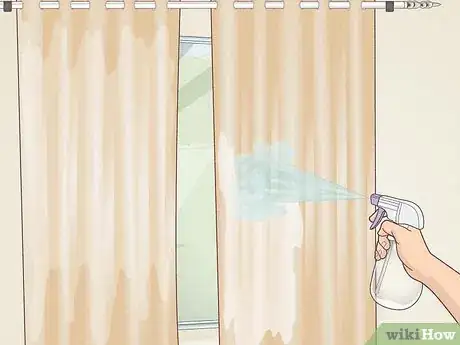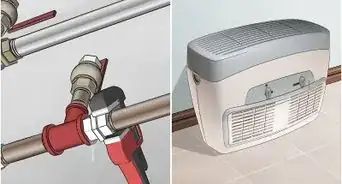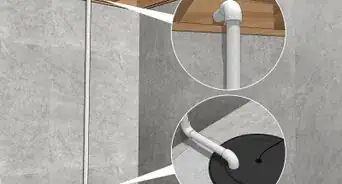This article was co-authored by Victor Belavus. Victor Belavus is an Air Conditioning Specialist and the Owner of 212 HVAC, an air condition repair and installation company based in Brooklyn, New York. In addition to HVAC and air conditioning units, Victor also specializes in furnace repair and air duct cleaning. He has over 10 years of experience working with HVAC systems.
There are 12 references cited in this article, which can be found at the bottom of the page.
This article has been viewed 98,665 times.
Dry air can have a big impact on your nasal passages, your skin, and even the wood fixtures in your home. Luckily, it's simple to add extra humidity to the air, even if you don't have a humidifier!
Steps
Using a Humidifier
-
1Select a humidifier for your room size. There are a number of humidifiers available. To humidify your room, the most important thing is getting one that is an appropriate capacity for the room in which you want it. Look on the box to check the square footage or square meter rating for the humidifier. Invest in a model that most closely matches your room’s size.[1]
- A humidifier’s size rating might not exactly match your room, but you want to buy the closest size possible. For example, if your room is 500 square feet, opt for a humidifier that covers up to 600 square feet. Going too small could leave your room too dry.
- Generally, a compact humidifier or tabletop humidifier will work in most bedrooms, while a tower humidifier will work in an office, living room, or other shared spaces.
-
2Assemble your humidifier. Every humidifier has slightly different directions for assembly, so take a look at your model’s manual first. Typically, you will need to connect your reservoir to the base, add the filter, and add any additional components such as wheels.[2]
- Typically, you won't need any tools to assemble your humidifier, but this could vary from model to model.
- Be sure to keep the humidifier on a flat surface when you're using it, and monitor the humidity in the room so you'll know when to turn it off.[3]
Advertisement -
3Fill your humidifier. Once your humidifier is assembled, you will need to fill the reservoir before turning it on. Fill it up to the designated fill line with clean, fresh water. Then, turn the unit on and set it to your desired humidity level.[4]
-
4Clean your humidifier regularly. The exact frequency at which you should clean your humidifier depends on a number of things, including the size of the unit and how often you use it. Look over the manufacturer recommendations regarding cleaning.[7] Wash out the reservoir with soap and warm water frequently, and change the filter as recommended in the model instructions.[8]
- As a general rule, do a light cleaning every week, and deep-clean and sanitize your humidifier about once a month.[9]
Getting Rid of the Causes of Dry Air
-
1Turn down the thermostat. Heating the room when it’s cold zaps moisture out of the air. Turn the heat down by three to five degrees and layer up in sweaters and blankets to help conserve some of the air’s natural moisture.[10]
-
2Seal up your doors and windows. Leaks around doors and windows can pull both warm air and moisture out of your home. Recaulk your windows, or add weather stripping around your windows and doors to seal up leaks.[11]
- Weather stripping typically has an adhesive backing and can easily be applied simply by pressing it around door and window frames.
-
3Minimize your use of heated appliances. Your dryer and your oven both dry out the air in the room around them. So do appliances like space heaters. Take a look at your room and see if there are any heated appliances that could be sucking out the moisture. If you find any, aim to use them less.[12]
- If an oven is the problem, consider trying something like meal prep where you only have to use it once or twice a week.
- If a dryer is the problem, try line-drying your clothes, or tumble drying on a no-heat setting.
- Avoid using small beauty tools like hair dryers and flat irons in the room you’re trying to humidify.
Adding Moisturizing Elements
-
1Cook with boiling water. When you do cook, try to make dishes that use boiling water. Pasta, rice, and potatoes are all good options. When you boil water, some of it will evaporate into the air, adding moisture to the surrounding areas.[13]
-
2Leave the bathroom door open when you shower. If your room is attached to or located near the bathroom, try leaving the door open when you shower. The steam from your shower will permeate throughout the room and add some water to dry air.[14]
-
3Place bowls of water throughout the room. Adding bowls of water around a room works kind of like a humidifier, but at a slower speed. Place a few bowls of water around the perimeter of the room you want to humidify and leave them there to allow the moisture to evaporate into the air.[15]
- If you have a radiator, you could place a ceramic or glass bowl of water on top to heat up the water and speed up the evaporation process. Placing the bowls in direct sunlight can also help.
-
4Add houseplants to the area. Plants release moisture through a process called transpiration, which can help bring some moisture back into your room.[16] Boston ferns, in particular, are recommended for their air moisturizing and purifying properties. Plant a few houseplants and keep them in a cluster in your room to get the greatest benefit.[17]
-
5Dampen your curtains. Use a spray bottle to mist your curtains with fresh water. Then, open your curtains enough to let light come through. The sunlight will help evaporate the water, which will add moisture into the area around the windows and in the room.[18]
Expert Q&A
Did you know you can get expert answers for this article?
Unlock expert answers by supporting wikiHow
-
QuestionHow often should I clean a room humidifier?
 Victor BelavusVictor Belavus is an Air Conditioning Specialist and the Owner of 212 HVAC, an air condition repair and installation company based in Brooklyn, New York. In addition to HVAC and air conditioning units, Victor also specializes in furnace repair and air duct cleaning. He has over 10 years of experience working with HVAC systems.
Victor BelavusVictor Belavus is an Air Conditioning Specialist and the Owner of 212 HVAC, an air condition repair and installation company based in Brooklyn, New York. In addition to HVAC and air conditioning units, Victor also specializes in furnace repair and air duct cleaning. He has over 10 years of experience working with HVAC systems.
Air Conditioning Specialist
References
- ↑ http://www.streetdirectory.com/travel_guide/26215/home_accessories/8_easy_steps_to_choosing_a_humidifier.html
- ↑ https://www.hunker.com/13407395/instructions-for-a-fantasy-humidifier
- ↑ Victor Belavus. Air Conditioning Specialist. Expert Interview. 6 May 2020.
- ↑ http://www.mayoclinic.org/diseases-conditions/common-cold/in-depth/humidifiers/art-20048021
- ↑ Victor Belavus. Air Conditioning Specialist. Expert Interview. 6 May 2020.
- ↑ Victor Belavus. Air Conditioning Specialist. Expert Interview. 6 May 2020.
- ↑ Victor Belavus. Air Conditioning Specialist. Expert Interview. 6 May 2020.
- ↑ https://learn.compactappliance.com/humidifier-mistakes/
- ↑ Victor Belavus. Air Conditioning Specialist. Expert Interview. 6 May 2020.
- ↑ http://www.criticalcactus.com/how-to-humidify-the-home/
- ↑ https://energy.gov/energysaver/air-sealing-your-home
- ↑ http://www.naturallivingideas.com/naturally-humidify-home-air/
- ↑ http://www.newhealthguide.org/How-To-Humidify-A-Room.html
- ↑ https://www.mnn.com/health/healthy-spaces/questions/how-can-i-naturally-humidify-my-home
- ↑ https://www.apartmenttherapy.com/how-to-add-moisture-to-the-air-107447
- ↑ https://water.usgs.gov/edu/watercycletranspiration.html
- ↑ https://www.mnn.com/health/healthy-spaces/questions/how-can-i-naturally-humidify-my-home
- ↑ http://www.criticalcactus.com/how-to-humidify-the-home/
About This Article
Humidifying your room can have a load of health benefits, like improving your breathing, reducing coughs, and hydrating your skin. If you have a humidifier at home, all you need to do is fill it with water to the fill line, turn it on, and set the humidity level you want. If you don’t have a humidifier, place a few bowls of water around the room so the water will evaporate into the air over time. If you have a radiator, place a ceramic or glass bowl of water on top to speed up the process. You can also humidify the room with houseplants, which release moisture into the air. Another thing you can do it mist your curtains with water from a spray bottle. The sunlight will help evaporate the water and humidify your room. For more tips, including how to take advantage of your shower’s steam, read on!
